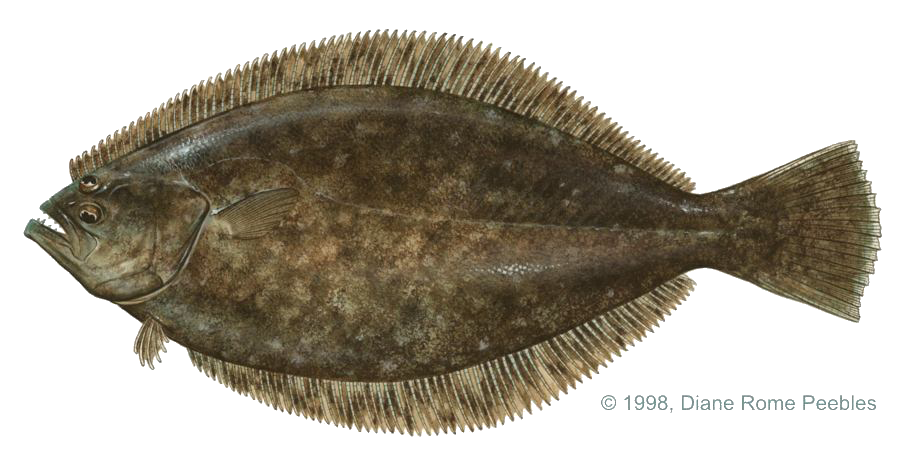Game Fish Identification Reference Guides
Halibut, California
(Paralichthys californicus)
(Paralichthys californicus)

(Ayres, 1859); BOTHIDAE FAMILY; also called chicken halibut, southern halibut, bastard halibut, portsider, alabato Monterey halibut
Occurs along the Pacific coast of North America from San Francisco, California, to Baja California, Mexico. There are scattered records of its occurrence as far north as the State of Washington. It is usually found on sandy bottoms in depths of 10 to 20 fathoms or less, though it may occasionally be found in depths up to 100 fathoms. It is not known to make any extensive migrations such as its larger northern relatives do.
This is the largest and most abundant flatfish within its normal range (south of San Francisco), growing to a weight of 60 lb (27 kg) and a length of 5 ft (1.97 m). Females grow larger, live longer, and are more numerous than males. Although is a member of the lefteye flounder family (Bothidae), it appears that nearly half of the population has both eyes on the right side of the body. The sighted side of the fish is usually brownish and the blind side white
They feed on anchovies, small fishes, crustaceans, squid, and mollusks. Drift fishing with live anchovies, shrimp, or queenfish is the most successful sportfishing method, though slow trolling has also been known to be effective. This species is not overly finicky and will sometimes take almost any kind of bait or lure.
The firm, white flesh is excellent eating. Sharks, rays, porpoises, and especially sea lions frequently prey upon this halibut
Occurs along the Pacific coast of North America from San Francisco, California, to Baja California, Mexico. There are scattered records of its occurrence as far north as the State of Washington. It is usually found on sandy bottoms in depths of 10 to 20 fathoms or less, though it may occasionally be found in depths up to 100 fathoms. It is not known to make any extensive migrations such as its larger northern relatives do.
This is the largest and most abundant flatfish within its normal range (south of San Francisco), growing to a weight of 60 lb (27 kg) and a length of 5 ft (1.97 m). Females grow larger, live longer, and are more numerous than males. Although is a member of the lefteye flounder family (Bothidae), it appears that nearly half of the population has both eyes on the right side of the body. The sighted side of the fish is usually brownish and the blind side white
They feed on anchovies, small fishes, crustaceans, squid, and mollusks. Drift fishing with live anchovies, shrimp, or queenfish is the most successful sportfishing method, though slow trolling has also been known to be effective. This species is not overly finicky and will sometimes take almost any kind of bait or lure.
The firm, white flesh is excellent eating. Sharks, rays, porpoises, and especially sea lions frequently prey upon this halibut













